Pump Handbook by Igor J. Karassik, Joseph P. Messina, Paul Cooper, Charles C. Heald - 3rd edition
Подождите немного. Документ загружается.

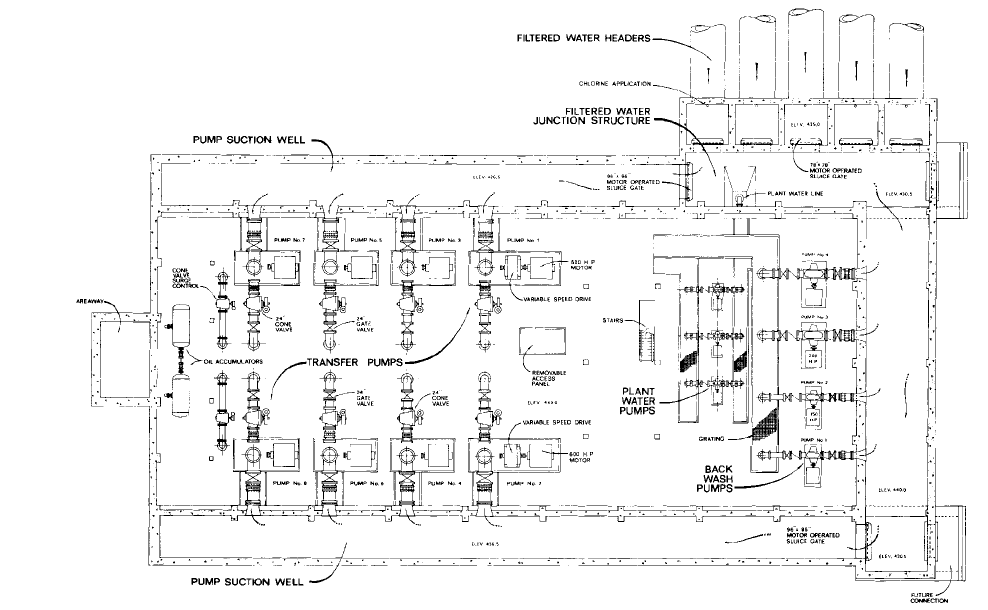
9.20
FIGURE 11 Plan of the high-service pumping station in the East Side w
ater treatment plant, Dallas (1 in = 2.54 cm; 1 ft 0.3048 m) (URS/Forrest and Cotton)
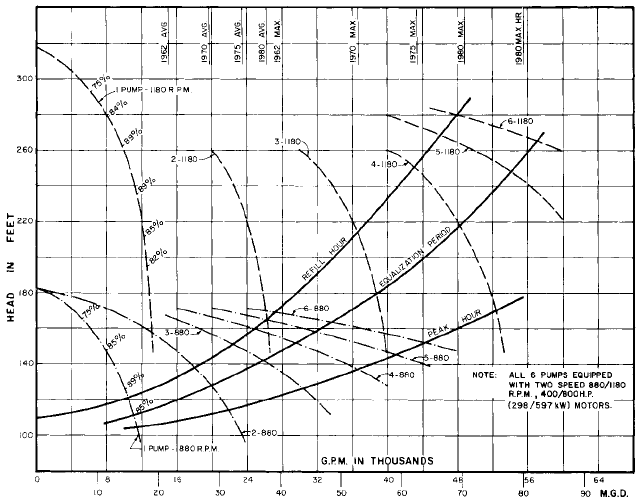
9.1 WATER SUPPLY 9.21
FIGURE 12 Typical system-head curves for high-service pumpage to water distribution system (1 ft = 0.3048 m;
1 gpm = 0.227 m
3
/h)
by topographical conditions and system layout. Booster stations may include in-line ver-
tical or horizontal pumps connected directly to the pipeline or separate storage reservoirs
and pumps. The latter method is preferred but is not always practicable because of land
requirements for the storage reservoir.
In-line booster pumps should be sized to match the capacities of incoming pipelines
and should be capable of supplying the additional head required to increase pressures to
desirable ranges in the affected area of the distribution system. Determination of dis-
charge head must take into account the pressure on the suction side of the pump as well
as static head, frictional losses, and desired residual pressure on the discharge side.
Many water utilities refuse to accept in-line pumps as satisfactory for booster service
and require construction of a pressure-equalizing storage reservoir. Horizontal or vertical
booster pumps then take suction from the storage reservoir and return water at higher
pressures to the mains. Pressure switches or floats automatically start and stop the
booster pumps and thus eliminate the need for continuous attendance.
GROUNDWATER WELLS_______________________________________________
Site Selection
Foremost among the factors that must be considered in selection of a site
for a proposed well are local regulations governing proximity to such potential contami-
nants as cesspools, privies, animal pens, or abandoned wells. Also to be considered is the
effect on adjacent wells
—
if wells are located too close together, excessive head losses may
result.

9.22 CHAPTER NINE
Types of Pumps Used The two basic types of pump used in groundwater wells are ver-
tical turbine, line shaft pumps, and submersible pumps. The vertical turbine pump con-
sists of three basic components: the driving head, the column-pipe assembly, and the bowl
assembly. The driving head is mounted above ground and consists of the pump discharge
elbow, the motor support, and the stuffing box. The column-pipe assembly (consisting of
shaft, bearings, and bearing retainers) and the bowl assembly (consisting of a suction
head, impeller or impellers, discharge bowl, and intermediate bowl or bowls) are sus-
pended from the driver head. Use of multiple bowls and impellers results in a form of
series operation and permits pumpage against very high heads.
The submersible pump utilizes a waterproof electric motor located below the static
level of the well to drive a series of impellers and produce a series operation similar to that
of a line shaft pump. However, the length of shafting required is greatly reduced, and thus
the shaft losses and total thrust are minimized. As a result, the submersible pump
becomes economically competitive with the line shaft pump at great depths.
Air-lift pumps, which operate on the principle that a mixture of air and water will rise
in a pipe surrounded by water, may be used in some cases. Such pumps are easy to main-
tain and operate and can be used in a crooked well or with sandy water. However, they are
relatively inefficient (usually 30 to 50%) and allow very little system flexibility.
Reciprocating pumps are also used in some cases where small capacities are required
from deep wells. Such pumps can be driven by electric motors or windmills, but they are
generally noisy and are more expensive than centrifugal pumps.
Determining Pump Capacity The capacity of any well is dependent on such factors as
screen size, well development, aquifer permeability, recharge of groundwater supply from
rainfall and streams, and available head. The basic procedure used in sizing a pump for
well service involves drilling the well and performing a test operation. First the static
head, or elevation of the groundwater table prior to pumping, is determined. Water is then
pumped at various rates and the drawdown associated with each pumping rate deter-
mined. A plot of drawdown versus pumping rate can then be derived. Pumping rate is usu-
ally measured by a weir, orifice, or pilot tube, and drawdown is determined with a detector
line and gage or with an electric sounder.
From the test data and from a preliminary layout of discharge piping, a system-head
curve can be derived, with drawdown added to frictional losses for each pumping rate.The
pump characteristic curve can then be superimposed on the system-head curve to deter-
mine the capacity that can be attained with a specific pump. It should be noted that pump
curves for line shaft pumps are based on the results of shop tests, which do not allow for
column frictional or line shaft and thrust losses. Consequently, the laboratory character-
istic curve for any line shaft pump must be adjusted to field conditions.
Field pumping head can be determined by subtracting column frictional losses from
the laboratory head. Field brake horsepower (brake kilowatts) is determined by adding
shaft brake horsepower (brake kW), which depends on shaft diameter and length, and on
rotative speed, to laboratory brake horsepower (brake kW). Field efficiency is determined
from the formula
In USCS units
In SI units
Because thrust loads cause additional losses in the motor bearing, it is necessary to
determine the additional power required to overcome thrust losses. Total thrust load is
equal to the sum of the shaft weight and the hydraulic thrust (which varies with labora-
tory head for any particular impeller), and losses due to thrust amount to approximately
0.0075 hp/100 rpm/1000 lb (0.00126 kW/100 rpm/1000 N) of thrust. Motor efficiency is
then calculated by dividing the motor’s full load power input (without thrust load) by the
sum of full load power input and loss due to thrust. Overall efficiency then equals the prod-
uct of field efficiency and motor efficiency.
Field efficiency
m
3
>h field head in meters
367.5 field brake kW
Field efficiency
gpm field head in feet
3960 field brake horsepower
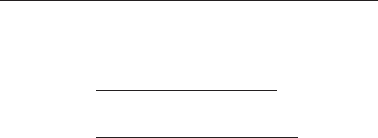
9.1 WATER SUPPLY 9.23
As a result of the efficiency losses produced by shaft weight and length in line shaft
pumps, it is usually more economical to use a submersible pump at depths of more than
about 500 ft (150 m). Sizing a submersible pump requires calculations similar to those for
a line shaft pump. However, the submersible pump installation requires a check valve in
the column pipe, which must be considered in the determination of frictional losses. More-
over, the efficiency losses resulting from the motor cable (expressed as a percentage of
input electric power) must be considered in determining overall efficiency, which can be
calculated from the formula:
where
in USCS units
in SI units
Cable size must be selected on the basis of motor power and motor input amperes, volt-
age, and cable length.
Well Stations A typical well station generally includes a small building for housing the
pump, pump controls, metering and surge-control facilities, and chemical feed equipment.
Submersible pumps do not require a pump house for protection, but if pump controls or
chemical feed equipment are provided, an enclosure of some type is required. Because well
water supplies are often pumped directly into the distribution system, a differential pro-
ducer is usually installed for metering. Moreover, chemicals may be added at the well sta-
tion to minimize corrosion, control bacteria, decrease hardness, and inject fluorides into
the water supply. Surges are usually controlled by installation of a surge valve in the
pump discharge line. Controls may also be installed to permit starting and stopping of the
pump from remote central locations and to provide for measurement and control of well
drawdown.
FURTHER READING __________________________________________________
Fair, G. M., Geyer, J. C., and Okun, D. A. Water and Wastewater Engineering, Wiley, New
York, 1968.
Karassik, I. J., and Carter, R. Centrifugal Pumps: Selection, Operation, and Maintenance.
McGraw-Hill, New York, 1960.
Messina, J. P. “Operating Limits of Centrifugal Pumps in Parallel.” Water and Sewage
Works. 1969, p. R
—
79.
Singley, J. E., and Black, A. P. “Water Quality and Treatment: Past, Present and Future.”
Journal AWWA. 64(1):6 (1972).
Texas Water Utilities Association. Manual of Water Utilities Operations. 5th ed., Lancaster
Press, Lancaster, Pa, 1969.
URS/Forrest and Cotton, Inc., Consulting Engineers. “Report to the City of Dallas on Dis-
tribution System Analysis.” January 1958.
Water power in kW
m
3
h field head in meters
367.5
Water power in hp
gpm field head in feet
3960
Overall efficiency
water power 1% motor efficiency % cable loss2
shop brake power 100

H. H. BENJES, SR.
W. E. FOSTER
D. A. HOUSE
9.25
SECTION 9.2
SEWAGE TREATMENT
Sewage is defined as the spent water of a community. Although it is more than 99.9% pure
water, it contains wastes of almost every form and description. Raw sewage, when fresh,
is gray and looks something like dirty dishwater containing bits of floating paper, garbage,
rags, sticks, and numerous other items. If allowed to go stale, it turns black and becomes
very malodorous. About 25% of the waste matter of normal domestic sewage is in suspen-
sion; the remainder is in solution.
Sewage contains many complex organic and mineral compounds. The organic portion
of sewage is biochemically degradable and, as such, is responsible for the offensive char-
acteristics usually associated with sewage. Sewage contains large numbers of microor-
ganisms, most of which are bacteria. Fungi, viruses, and protozoa are also found in sewage,
but to a lesser extent. Although most of the microorganisms are harmless and can be used
to advantage in treating the sewage, the viruses and some of the bacteria are pathogenic
and can cause disease.
Sewage flow generally averages between 50 and 200 gallons per capita per day (gpcd)
(190 and 760 lpcd). In the absence of better information, an average figure of 100 gpcd (380
lpcd) is generally used for design purposes.The rate of flow usually varies from minimum
in the early morning to maximum in the later afternoon. Minimum flow ranges from 50 to
80% and maximum dry-weather flow from 140 to 180% of average flow. The extent of vari-
ation decreases as the size of the system increases. Wet-weather flows can be 600 gpcd
(2270 lpcd) or more because of the extraneous water entering sewers from roof drains,
areaway drains, footing drains, and so on.
SEWAGE SYSTEMS __________________________________________________
In most instances, sewage systems are divided into two parts: collection systems and treat-
ment systems.
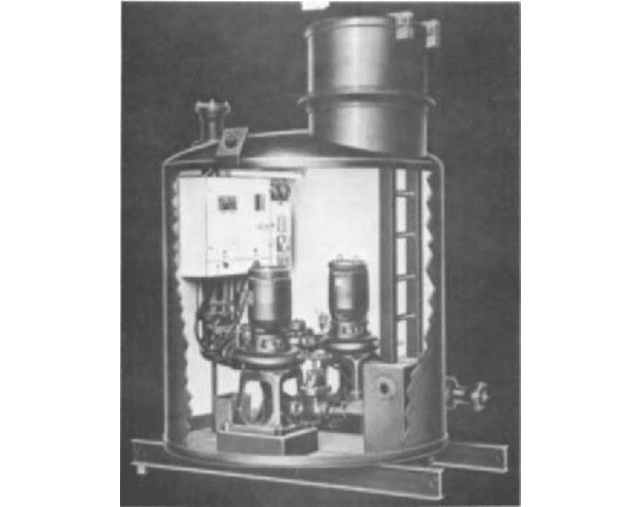
9.26 CHAPTER NINE
FIGURE 1 Factory-built conventional lift station (Smith & Loveless, Inc.)
Collection Collection systems consist of a network of sewers that collect and convey
sewage from individual residences, commercial establishments, and industrial plants to
one or more points of disposal. Pumping stations are often needed at various points in the
system to pump from one drainage area to another or to the treatment plant. The judi-
cious location of pumping stations enhances the economy of the overall design by elimi-
nating the need for extremely deep sewers.
Small-system pumping stations (Figures 1 and 2) are frequently built underground
and may be factory-built. For larger stations, superstructures should be in keeping with
surrounding development. It has been said that people smell with their eyes and their
ideas as well as their noses, and for this reason aboveground structures should be attrac-
tive, with landscaped grounds, to overcome the popular prejudices against sewage works.
Stations can be and have been designed and constructed in residential areas where the
neighbors apparently are not aware that the stations are not homes.
Treatment Treatment facilities can be many and varied, with the extent and nature of
the treatment determined to a large degree by the proposed use of the receiving stream
and its ability to assimilate pollutants. Most conventional treatment plants being built
today can be classified as either primary, biological, or advanced waste treatment. Other
alternatives, such as physical-chemical or chemical-biological treatment, are also used on
occasion but on a lesser scale.The treatment needs of smaller communities are sometimes
satisfied by package treatment plants or by waste stabilization lagoons.
Primary treatment involves removal of a substantial amount of the suspended solids
but little or no colloidal or dissolved matter. Primary treatment facilities normally include
screening, grit removal, and primary sedimentation. The sewage is often chlorinated dur-
ing primary treatment in order to sterilize the wastes.
Biological treatment uses bacteria and other microorganisms to break down and sta-
bilize the organic matter. Trickling filters and the many variations of the activated sludge
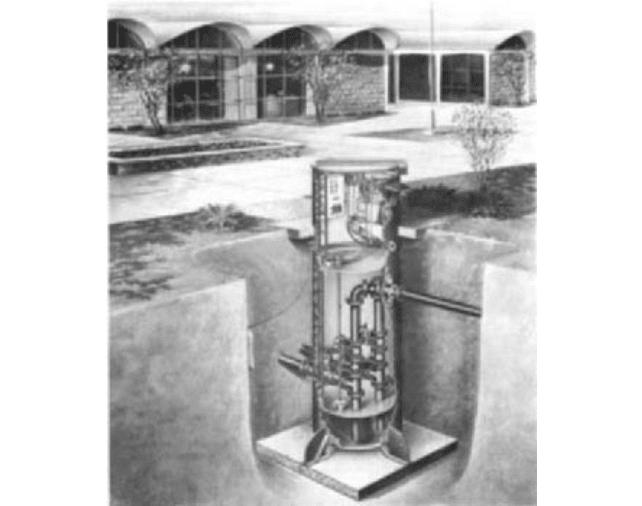
9.2 SEWAGE TREATMENT 9.27
FIGURE 2 Factory-built pneumatic ejector lift station (Smith & Loveless, Inc.)
process are the most popular biological treatment concepts presently in use. Biological
treatment is generally followed by final sedimentation of the solids produced by the
microorganisms.
Advanced waste treatment is a very complex subject, and it can range from a limited
objective, such as phosphate removal, to whatever additional treatment is necessary for
water reuse purposes. Advanced waste treatment usually follows conventional primary
and biological treatment and can include phosphate removal, nitrate removal, multimedia
filtration, carbon absorption, and ion exchange. Where zero discharge is required, it may
be necessary to follow advanced waste treatment with spray irrigation of the plant efflu-
ent or other methods of disposal.
Combined primary and biological treatment using the activated sludge process is
perhaps the most commonly used treatment concept currently in use. A schematic
drawing of a typical activated sludge treatment plant is shown in Figure 3. In the exam-
ple, liquid treatment is accomplished by coarse screening, grit removal, fine screening
(or communication), and primary settling, followed by aeration, final settling, and chlo-
rination. Sludge processing includes thickening, dewatering, incineration, and liquid
disposal of ash. There are many variations to this layout, but the one shown includes
most of the pumping applications normally encountered in treatment plant design.
Pumping requirements will of course vary from plant to plant, depending on the process
used, the site size and topography, and the relative location of the various structures
and equipment.
PUMP APPLICATIONS ________________________________________________
Most of the pumping applications associated with the collection and treatment of sewage
can be classified according to the general nature of the liquid to be handled. The primary
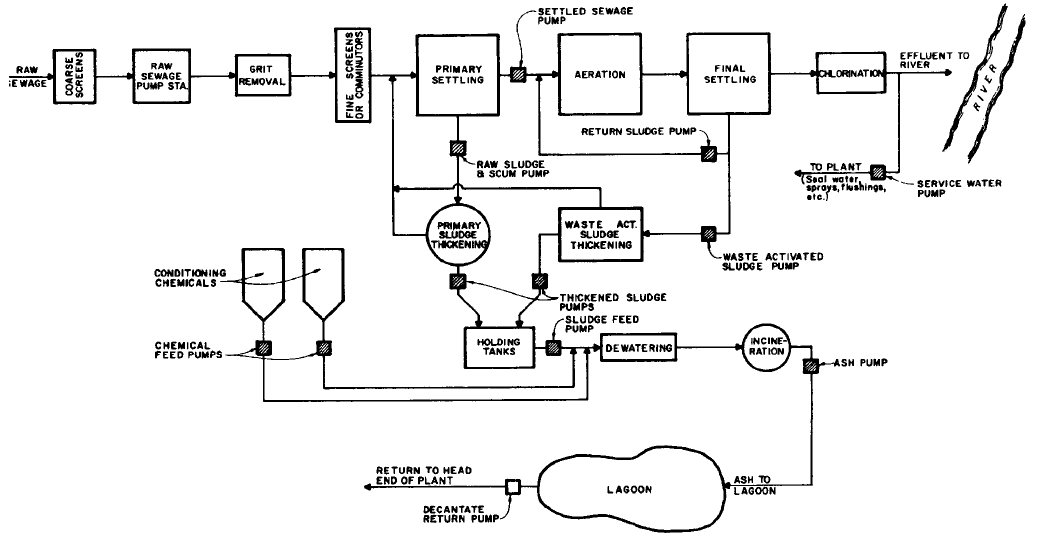
9.28
FIGURE 3 Typical activated sludge plant, with dewatering, incineration, and liquid disposal of ash
9.2 SEWAGE TREATMENT 9.29
classifications are (1) raw sewage, (2) settled sewage, (3) service water, and (4) sludge.
There are also, however, a number of specialized applications involving the handling of
abrasive materials, such as grit and ash. The types of pumps recommended for sewage
applications are indicated in Table 1. Although included in the table, chemical pumps are
not discussed in this section. They are covered in Section 9.6.
Raw Sewage Raw sewage pumps are used to lift liquid wastes from one level of the col-
lection system to another or to the treatment plant for processing. Regardless of where
the pumps are located, the basic design considerations remain the same.
Even though the sewage is normally screened at larger installations before entering
the suction wet well, it still contains a large quantity of problem material, such as grit,
rags, stringy trash, and miscellaneous solids small enough to pass through the coarse
screens. Screens are often omitted from smaller installations because large objects are not
as much of a problem because of the smaller size of the incoming sewers.
Raw sewage pumping installations are usually sized so their firm capacity either is
equal to a future maximum flow rate of the incoming sewers or can be expanded to
accommodate this level. Firm capacity is defined as total station capacity with one or more
of the largest units out of service.
Pneumatic ejectors (Figure 2) are sometimes used where the required capacity is less
than that provided by the smallest conventional sewage pump. This type of unit, however,
should not be used where more than 50 connections are expected.
Conventional sewage pumps are, by far, the most common pumps used for the handling
of raw sewage. A conventional sewage pump is more specifically described as an end-
suction, volute-type centrifugal with an overhung impeller of either the nonclog (Figure
4a) or the radial- or mixed-flow type (Figure 5), depending on capacity and head.
Nonclog pumps are all based on an original development by Wood at New Orleans.
Actually, no pump has been developed that cannot clog, either in the pump or at its appur-
tenances. Experience shows that rope, long stringy rags, sticks, cans, rubber and plastic
goods, and grease are most conducive to clogging.
Nonclog impellers are used almost exclusively today for pumps smaller than 10 in (25
cm). These pumps differ from clear-water pumps in that they are designed to pass the
largest solids possible for the pump size. The conventional nonclog impeller contains two
blades, although some manufacturers are now offering a single-blade (“bladeless”)
impeller. The two-blade impeller has thick vanes with large fillets between the vanes and
the shroud at the vane entrance. The bladeless impeller has no vane tips to catch trash.
On the other hand, it is inherently out of balance because of its lack of symmetry.
The larger raw sewage pumps are equipped with either mixed-flow or radial-flow
impellers, depending on head conditions. Both have two or more vanes, depending on
pump size and the size of solids to be handled. The vane tips are sharper than for the non-
clog impeller, resulting in a higher operating efficiency. The heavier vanes are not neces-
sary because the vane openings can be larger than on the smaller pumps. Experience
indicates that stringy trash will not clog an impeller with vane openings larger than 4 in
(102 mm) in diameter.
Conventional solids handling volute type sewage pumps may be of the dry pit type
(Figure 4a), wet pit type (Figure 4b), or submersible type (Figure 4c). Dry pit pumps are
by far the most popular and widely used type due to their accessibility for observing
mechanical operation and ease of maintenance when necessary.
Wet pit solids handling pumps are gaining in popularity especially on return activated
sludge services. They are similar in design to a vertical turbine or mixed-flow diffuser
pump except the bowl contains a limited number (usually two) of well-rounded diffusers,
the impeller is of the solids handling type, and there is no lower suction bell bearing.
Therefore, they are not nearly as likely to clog on the debris normally found in raw sewage.
Single-stage models available at the time of this publication are limited to operational
total heads under 100 ft (30 m).
Submersible solids handling pumps are commonly used in small raw sewage lift sta-
tions. They are most widely used in sizes 12 in (305 mm) and smaller with total heads
under 100 ft (30 m) and motor ratings under 150 HP (112 kW).
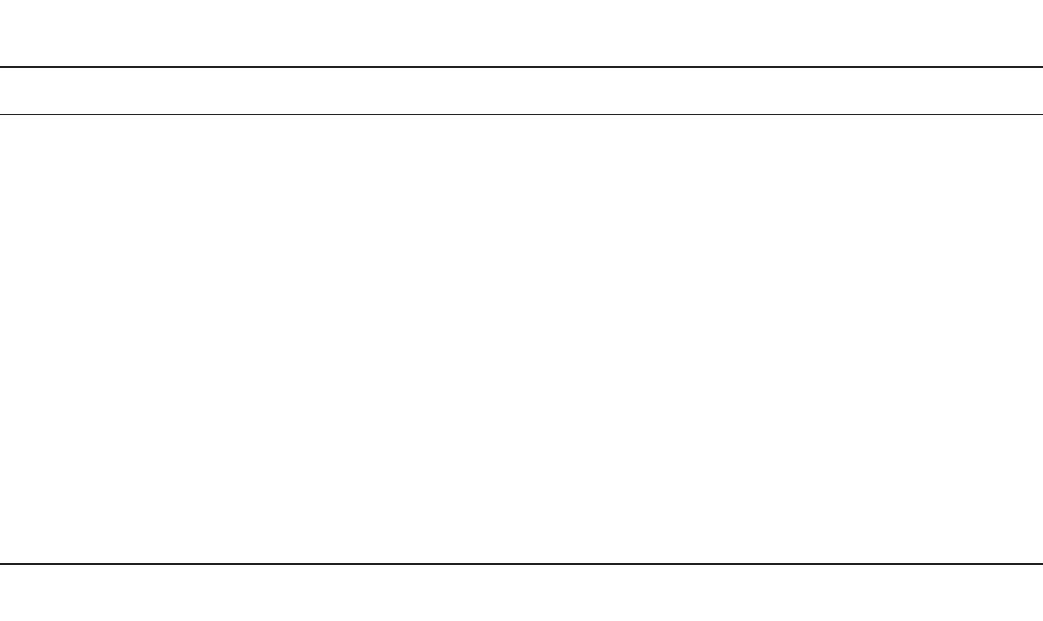
9.30
TABLE 1 Types of pumps generally used in sewage applications
Application Conventional Torque Clear-water Pneumatic Air Positive
sewage Diffuser flow volute Ash Screw ejector lift displacement Chemical
Raw Sewage X ... ... ... ... X X ... ... ...
Grit ... ... X ... ... ... ... X ... ...
Primary sludge
Less than 2% X . . . X . . . . . . . . . . . . . . . . . . . . .
solids
More than 2% . . . . . . . . . . . . . . . . . . . . . . . . X . . .
solids
Normal primary . . . . . . . . . . . . . . . . . . . . . . . . X . . .
scum
Diluted scum X . . . . . . . . . . . . . . . . . . . . . . . . . . .
Biological sludge X X . . . . . . . . . X . . . X . . . . . .
Thickened . . . . . . . . . . . . . . . . . . . . . . . . X . . .
biological sludge
Digested sludge, X . . . X . . . . . . . . . . . . . . . . . . . . .
recirculation
Settled sewage X X . . . . . . . . . X . . . . . . . . . . . .
Plant effluent X X . . . . . . . . . X . . . . . . . . . . . .
Service or X X . . . X . . . . . . . . . . . . . . . . . .
nonpotable water
Ash sluice . . . . . . . . . . . . X . . . . . . . . . . . . . . .
Decantate or X X . . . . . . . . . . . . . . . . . . . . . . . .
supernatant liquor
Chemical solution . . . . . . . . . . . . . . . . . . . . . . . . . . . X
